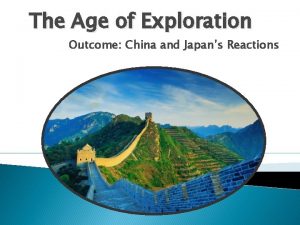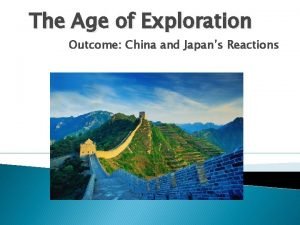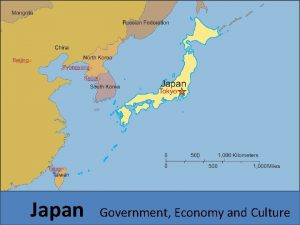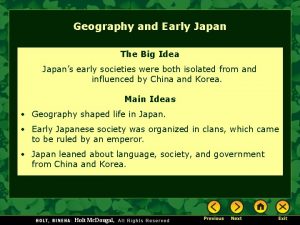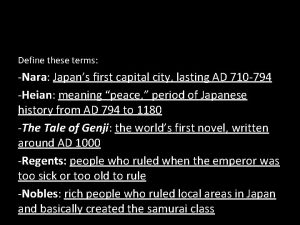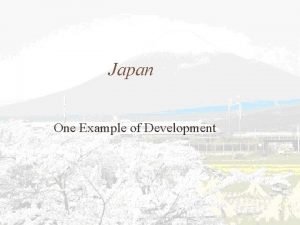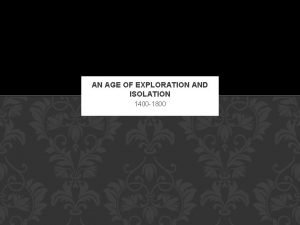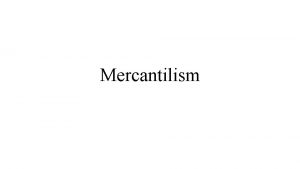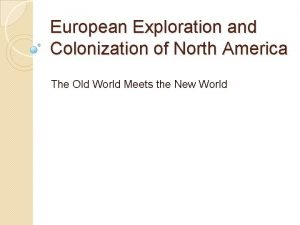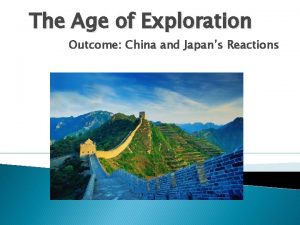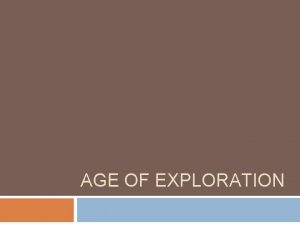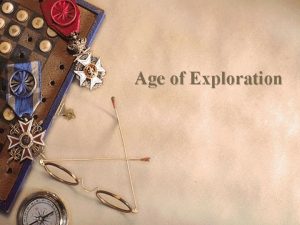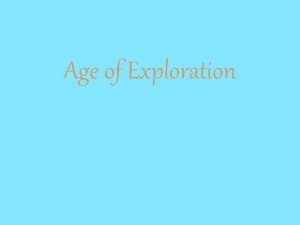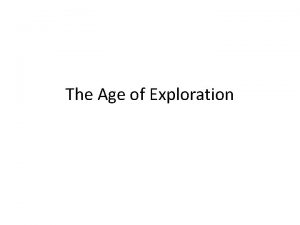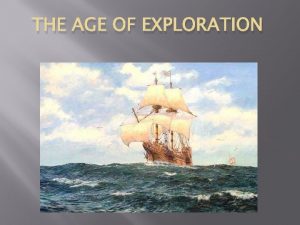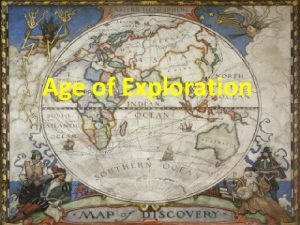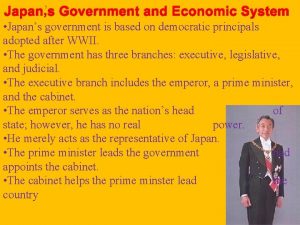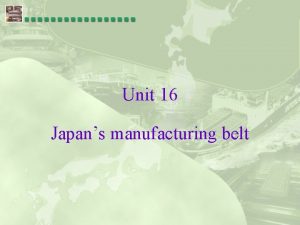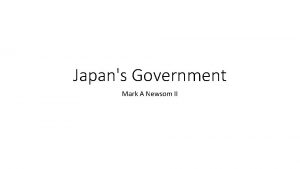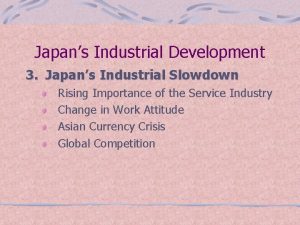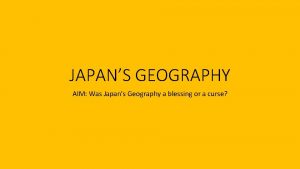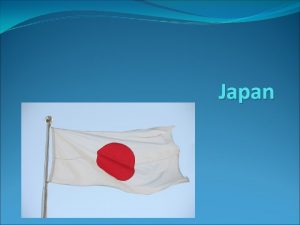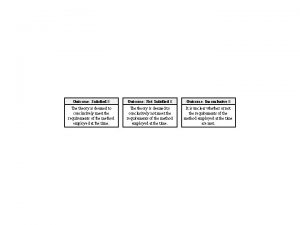The Age of Exploration Outcome China and Japans


























- Slides: 26

The Age of Exploration Outcome: China and Japan’s Reactions

The Age of Exploration 1. Setting the Stage a. East Asia was a hot spot for luxury goods b. Many Europeans were looking to trade with China and Japan

2. The Age of Exploration Ming & Qing China a. The Chinese people had rebelled and driven out their Mongol (Yuan) rulers and had established the Ming Dynasty (1368 -1644) b. The Ming government had ruled for 200 years and was weakening c. Later, the Manchus, people from Manchuria, invaded China and established the Qing Dynasty which ruled for 260 years

The Age of Exploration 3. The Ming Dynasty & The Voyages of Zheng He a. Emperor Hongwu and son Yonglo were curious about the outside world and launched voyages of exploration b. Chinese Admiral Zheng He led seven voyages c. Purpose of Voyages: Show of China’s might and power

3. The Age of Exploration The Voyages of Zheng He & The Ming Dynasty d. Voyages ranged from Southeast Asia to eastern Africa e. From 40 to 300 ships sailed on each voyage f. Some ships were 400 feet long (p. 537)

3. The Age of Exploration The Voyages of Zheng He & The Ming Dynasty g. Voyages included sailors, soldiers, carpenters, interpreters, accountants, doctors and religious leaders h. After 7 th voyage and Zheng He’s death, China withdrew into isolation and destroyed the fleet

4. The Age of Exploration Ming Relations with Foreign Countries & Rules a. China’s trade policies in the 1500 s reflected isolation b. If foreign states wanted to trade with China, they would have to follow Chinese rules because the Chinese did not want Europeans threatening the peace and prosperity the Ming had brought to China. c. China had a long history of being self-sufficient as well

4. The Age of Exploration Ming Relations with Foreign Countries & Rules d. Rules a. Only the government was allowed to conduct foreign trade b. Trading was only allowed at certain ports c. China expected Europe to pay tribute to Ming leaders; d. Tribute is a peace tax e. f. Kowtow ritual: kneeling in front of the emperor and touching forehead to ground 9 times The Dutch accepted these restrictions and were allowed to trade

The Age of Exploration 6. a. b. Japan In 1467, civil war shattered Japan’s feudal system and the country became chaotic Warrior chieftains called daimyos became lords in a new Japanese feudalistic system

The Age of Exploration 7. a. b. c. d. e. Contact Between Europe and Japan Europeans began coming to Japan in the 16 th century and were welcomed Within a century, the aggressive Europeans had worn out their welcome The Portuguese brought clocks, eyeglasses, tobacco, and firearms By 1600, European missionaries had converted 300, 000 Japanese to Christianity After peasant rebellion (most were Christian) the shoguns ruthlessly persecuted Christians and led to the formation of an exclusion policy

The Age of Exploration 8. The Closed Country Policy a. 1639 the shoguns sealed Japan’s borders and excluded merchants and missionaries b. Only port of Nagasaki remained open but only to Dutch and Chinese traders c. Lasted for more than 200 years d. Why? ? ? a. Japanese were forbidden to leave so as to not bring back foreign ideas b. Japan wanted to continue to develop as a selfsufficient country

The Age of Exploration � Result: Europeans begin to explore west across the Atlantic Ocean to the New World.

Ming and Qing Construction Great Wall, Forbidden City, Summer Palace, and Heavenly Temple.

• The Great Wall as we know it today was mainly built during the Ming Dynasty • Took over 100 Years to complete • Main spot for tourists is around Beijing • Was added on to because the Ming’s were trying to keep the Yuan forces out. They spared no effort in building, fortifying, extending, and eventually completing the construction of the wall Ming Dynasty Great Wall

Great Wall Dynasties

Forbidden City

• Lying at the city center of Beijing, it was the imperial palace for twenty-four emperors during the Ming and Qing dynasties. It was first built throughout 14 years during the reign of Emperor Chengzu in the Ming Dynasty (1368 -1644). Ancient Chinese Astronomers believed that the Purple Star (Polaris) was in the center of heaven and the Heavenly Emperor lived in the Purple Palace. The Palace for the emperor on earth was so called the Purple City. It was forbidden to enter without special permission of the emperor. Hence its name 'The Purple Forbidden City', usually 'The Forbidden City'. Forbidden City

• Having been the imperial • It is divided into two parts. palace for some five centuries, • The southern section, or the it houses numerous rare Outer Court was where the treasures and curiosities. Listed emperor exercised his supreme by UNESCO as a World power over the nation. Cultural Heritage Site in 1987, • The northern section, or the Palace Museum is now one Inner Court was where he lived of the most popular tourist with his royal family. attractions world-wide. Division

• Construction of the palace complex began in 1407, the 5 th year of the Yongle reign of the third emperor (Emperor Chengzu, Zhu Di) of the Ming dynasty. It was completed fourteen years later in 1420, and then the capital city was moved from Nanjing to Beijing the next year. It was said that a million workers including one hundred thousand artisans were driven into the long-term hard labor. Stone needed was quarried from Fangshan District. It was said a well was dug every fifty meters along the road in order to pour water onto the road in winter to slide huge stones on ice into the city. Huge amounts of timber and other materials were freighted from faraway provinces. Ancient Chinese people displayed their very considerable skills in building it. Take the grand red city wall for example. It has an 8. 6 meters wide base reducing to 6. 66 meters wide at the top. The angular shape of the wall totally frustrates attempts to climb it. The bricks were made from white lime and glutinous rice while the cement is made from glutinous rice and egg whites. These incredible materials make the wall extraordinarily • Since yellow is the symbol of the royal family, it is the dominant color in it. Roofs are built with yellow glazed tiles; decorations in the palace are painted yellow; even the bricks on the ground are made yellow by a special process. Construction

• Each of the 9, 999 rooms is decorated with statues. As the importance of each building grows, the number of statues increases. The most important room has a maximum of 10 statues. • The Forbidden City also contained the residences of the emperor’s concubines. One emperor had over 10, 000 of them, but the last emperor had only two. Fun Facts

• Two giant lion statues, one male and one female, guard the entrance to the inner palace. The male has a silk ball under his paw that represents power, and the female has a cub understand her’s that represents life. • In addition to the many gates, there is also a moat surrounding the palace. It used to contain metal stakes to deter people from trying to swim across. Fun Facts Continued

Summer Palace

• The construction started in 1750 as a luxurious royal garden for royal families to rest and entertain. It later became the main residence of royal members in the end of the Qing Dynasty. However, like most of the gardens of Beijing, it could not elude the rampages of the Anglo-French Allied Force and was destroyed by fire. • According to historical documents, with original name as 'Qingyi Garden' (Garden of Clear Ripples), the Summer Palace (Yiheyuan) was renamed after its first reconstruction in 1888. It was also recorded that Empress Dowager Cixi embezzled navy funds to reconstruct it as a resort in which to spend the rest of her life. In 1900, Yiheyuan suffered another hit by the Eight-Power Allied Force and was repaired in the next two years. In 1924, it was open to the public. It ranked amongst the World Heritage Sites by UNESCO in 1998. Construction

• The Marble Boat was built in 1755 with a base made from huge stones. The base supported a wooden pavilion in traditional Chinese style imitating the sailing boats of Emperor Qianlong (1711 - 1799). • The boat replaced a platform belonging to Yuanjing Temple during the Ming Dynasty (1368 - 1644). • In 1860, the wooden pavilion was burned leaving only the hull of the boat remaining. Empress Dowager Cixi had the boat rebuilt in 1893 using a Western design. She financed the rebuilding using funds embezzled from the navy. When the empire was facing a military and political crisis, Cixi embezzled more funds to rebuild the Summer Palace under the guise of naval development. The only concession actually made to the navy was that they took possession of the marble boat. As magnificent as the boat was, it was, of course, no use to the navy. In fact, Qing's Navy was completely vanquished in sea battled seven years later. Marble Boat

Temple of Heaven

• The Temple of Heaven Park is located in the Chongwen District, Beijing. • Originally, this was the place where emperors of the Ming Dynasty (1368 - 1644) and Qing Dynasty (1644 - 1911) held the Heaven Worship Ceremony. • It is China's largest and most representative existing masterpiece among China’s ancient sacrificial buildings. First built in 1420, the 18 th year of the reign of Emperor Yongle of the Ming Dynasty (1368 - 1644), it was enlarged and rebuilt during the reigns of the Ming emperor Jiajing and the Qing emperor Qianlong. • In 1988, it was opened to the public as a park, showing ancient philosophy, history and religion. Its grand architectural style and profound cultural connotation give an insight into the practices of the ancient Eastern civilization. Temple of Heaven
 The age of exploration outcome china and japan's reactions
The age of exploration outcome china and japan's reactions What was the outcome of china's age of exploration?
What was the outcome of china's age of exploration? The age of exploration outcome the atlantic slave trade
The age of exploration outcome the atlantic slave trade The age of exploration outcome the atlantic slave trade
The age of exploration outcome the atlantic slave trade Iron age bronze age stone age timeline
Iron age bronze age stone age timeline Iron age bronze age stone age timeline
Iron age bronze age stone age timeline Japans educational system
Japans educational system North korea type of government
North korea type of government Japans physical geography
Japans physical geography Japanese feudal hierarchy
Japanese feudal hierarchy Meaning of nara in japanese
Meaning of nara in japanese Japnese xxxx
Japnese xxxx Japans geography
Japans geography Japans isolation
Japans isolation The golds god
The golds god Why was gold a motivation for exploration
Why was gold a motivation for exploration Dutch exploration routes
Dutch exploration routes Chapter 19 an age of exploration and isolation
Chapter 19 an age of exploration and isolation God gold and glory
God gold and glory Mercantilism
Mercantilism Ggg
Ggg Age of exploration chart
Age of exploration chart Age of exploration videos
Age of exploration videos Cool antarctica.com
Cool antarctica.com European explorers webquest
European explorers webquest Jacques cartier legacy
Jacques cartier legacy Triangular trade
Triangular trade
